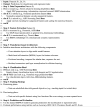MDNCT: a multi-domain neurocognitive transformer architecture approach for early prediction of autism spectrum disorders
- PMID: 40691484
- PMCID: PMC12280032
- DOI: 10.1038/s41598-025-09862-7
MDNCT: a multi-domain neurocognitive transformer architecture approach for early prediction of autism spectrum disorders
Abstract
Intellectual disability (ID) refers to a disorder involving intelligence and adaptive behavior that meets specific criteria involving deviance from the norm in terms of degree. ID is more common in males than females, and the causes can be genetic or environmental. This population has historically been characterized by significantly decreased life expectancy because they have not been diagnosed and treated for such diseases as cardiovascular and respiratory ones. However, medical progress in the last few years has slightly narrowed this gap, highlighting that understanding ID requires its consideration as a comorbidity to neurodevelopmental and cognitive diseases like Autism Spectrum Disorder (ASD), dementia, or learning disability. Thus, this work proposes the multi-domain NeuroCognitive Transformer (MDNCT) suitable for different prediction tasks on different datasets. Therefore, MDNCT obtains high performance based on the adequate preprocessing level according to the domain data's specific characteristics, more advanced feature extraction methods, and the use of Transformer-based neural networks. The structure of the framework incorporates common means to align multiple features across modalities and also other state-of-the-art features like multi-head self-attention and residual connections for learning. The use of the MDNCT includes important domains, including early dementia diagnostics for health purposes, social media comments toward learning disabilities, and effective identification of ASD in toddlers.
Keywords: Artificial intelligence; Autism spectrum disorder (ASD); Multi-domain analysis; NeuroCognitive transformer architecture; Neurodevelopmental disorders; Self-attention mechanism.
© 2025. The Author(s).
Conflict of interest statement
Declarations. Competing interests: The authors declare no conflict of interests.
Figures
Similar articles
-
Short-Term Memory Impairment.2024 Jun 8. In: StatPearls [Internet]. Treasure Island (FL): StatPearls Publishing; 2025 Jan–. 2024 Jun 8. In: StatPearls [Internet]. Treasure Island (FL): StatPearls Publishing; 2025 Jan–. PMID: 31424720 Free Books & Documents.
-
All-Cause Mortality and Specific Causes of Death in Autism: A Nationwide Analysis.Autism Adulthood. 2025 Feb 5;7(1):81-92. doi: 10.1089/aut.2023.0103. eCollection 2025 Feb. Autism Adulthood. 2025. PMID: 40151655
-
Sexual Harassment and Prevention Training.2024 Mar 29. In: StatPearls [Internet]. Treasure Island (FL): StatPearls Publishing; 2025 Jan–. 2024 Mar 29. In: StatPearls [Internet]. Treasure Island (FL): StatPearls Publishing; 2025 Jan–. PMID: 36508513 Free Books & Documents.
-
Differently different?: A commentary on the emerging social cognitive neuroscience of female autism.Biol Sex Differ. 2024 Jun 13;15(1):49. doi: 10.1186/s13293-024-00621-3. Biol Sex Differ. 2024. PMID: 38872228 Free PMC article. Review.
-
The Black Book of Psychotropic Dosing and Monitoring.Psychopharmacol Bull. 2024 Jul 8;54(3):8-59. Psychopharmacol Bull. 2024. PMID: 38993656 Free PMC article. Review.
References
-
- Posserud, M., Skretting Solberg, B., Engeland, A., Haavik, J. & Klungsøyr, K. Male to female ratios in autism spectrum disorders by age, intellectual disability and attention-deficit/hyperactivity disorder. Acta Psychiatr. Scand.144, 635–646 (2021). - PubMed
-
- Reppermund, S., Srasuebkul, P., Dean, K. & Trollor, J. Factors associated with death in people with intellectual disability. J. Appl. Res. Intellect. Disabil.33, 420–429 (2020). - PubMed
MeSH terms
LinkOut - more resources
Full Text Sources
Medical
Miscellaneous



